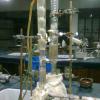Hi All,
This is first time am involved in fire fighting network design for a NG process plant. Before that had only the operational and constructional experience on this system. Some of the queries underlie here for fire fighting by water:
1. How many fire hydrant should be installed in the whole plant area? The distance between two hydrant should be similar in the whole area? Or the distance varies regarding main process area, tank area, oil loading area etc? Is it needed to check the vendor's catalog firstly to determine the throw range?
2. What should be the criteria for sizing the main fire water pump? As it mainly depends on the number of fire hydrant will run at a time and the respective flowrate, the consideration is important to run the number of hydrant at a time. If there is 20 hydrants in the plant area, the main fire water pump sizing should be done for the flowrate requred for 20 hydrants running at a time or something like 5 or 10 hydrants running at a time?
3. Deep well pump (submersible pump) can be used for the fire water reservoir filling. The thing is what should be the time required for the filling up the water reservoir like 4 hrs/10 hrs/30 hrs/ ...?
4. What are the standards for practicing this work? Which part of NFPA is dealing with it?
Thanks in advance for your time.

 FB
FB












